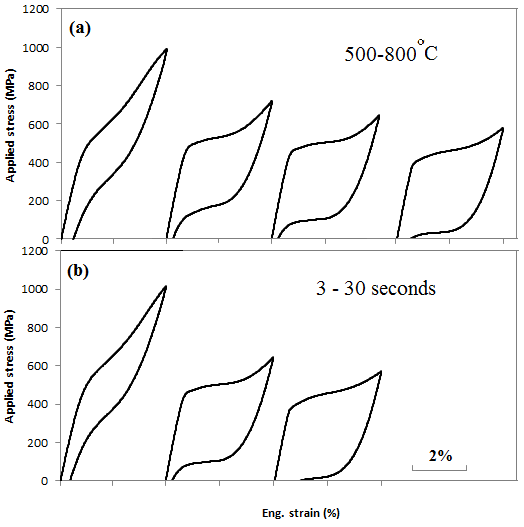Services
Simplify your process
Dr. S. Cai, Research and Development Engineer
While Nitinol is becoming more and more popular in the world of medical devices due to its superelastic and shape memory properties, its nickel content is cause for concern with some applications. The Fort Wayne Metals R & D team has therefore begun investigating nickel-free alternatives. An example is our recently developed Ni-free beta Ti alloy that has a recoverable strain of ~3.8% after the proper heat treatment (Figure 1). It has a tensile strength over 150KSI and a fatigue life over 1 million cycles at 0.5% strain. It fills the gap between NiTi and stainless steel in certain applications. Its unique properties (super-elastic strain) are the result of the relatively low modulus (between NiTi and 304 SS) and stress-induced martensite phase transformation (Figure 2). This example shows our continuous interests and strength in high performance titanium alloys.

Figure 1 – Elastic property tuning by shape-setting a single composition of beta Ti alloys at various temperature and time.

Figure 2 – In-situ synchrotron X-ray diffraction shows the stress-induced martensite during tensile test. a)-c) diffraction image during loading and unloading cycle, d) diffraction spectrum before deformation, e) diffraction spectrum at the peak stress.
Click here to see previous highlights.
Disclaimer: Our monthly highlights are sneak peeks of what our R & D department is working on. This does not mean we have what is referenced above ready for manufacturing.
Dr. S. Cai, Research and Development Engineer
While Nitinol is becoming more and more popular in the world of medical devices due to its superelastic and shape memory properties, its nickel content is cause for concern with some applications. The Fort Wayne Metals R & D team has therefore begun investigating nickel-free alternatives. An example is our recently developed Ni-free beta Ti alloy that has a recoverable strain of ~3.8% after the proper heat treatment (Figure 1). It has a tensile strength over 150KSI and a fatigue life over 1 million cycles at 0.5% strain. It fills the gap between NiTi and stainless steel in certain applications. Its unique properties (super-elastic strain) are the result of the relatively low modulus (between NiTi and 304 SS) and stress-induced martensite phase transformation (Figure 2). This example shows our continuous interests and strength in high performance titanium alloys.

Figure 1 – Elastic property tuning by shape-setting a single composition of beta Ti alloys at various temperature and time.

Figure 2 – In-situ synchrotron X-ray diffraction shows the stress-induced martensite during tensile test. a)-c) diffraction image during loading and unloading cycle, d) diffraction spectrum before deformation, e) diffraction spectrum at the peak stress.
Click here to see previous highlights.
Disclaimer: Our monthly highlights are sneak peeks of what our R & D department is working on. This does not mean we have what is referenced above ready for manufacturing.